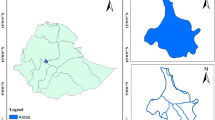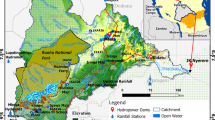Abstract
Flood spreading is a suitable strategy for controlling and benefiting from floods. Selecting suitable areas for flood spreading and directing the floodwater into permeable formations are amongst the most effective strategies in flood spreading projects. Having combined geographic information systems (GIS) and multi-criteria decision analysis approaches, the present study sought to locate the most suitable areas for flood spreading operation in the Garabaygan Basin of Iran. To this end, the data layers relating to the eight effective factors were prepared in GIS environment. This stage was followed by elimination of the exclusionary areas for flood spreading while determining the potentially suitable ones. Having closely examined the potentially suitable areas using the Preference Ranking Organization Method for Enrichment Evaluations (PROMETHEE) II and analytic hierarchy process (AHP) methods, the land suitability map for flood spreading was produced. The PROMETHEE II and AHP were used for ranking all the alternatives and weighting the criteria involved, respectively. The results of the study showed that most suitable areas for the artificial groundwater recharge are located in Quaternary Qg and Qgsc geologic units and in geomorphological units of pediment and Alluvial fans with slopes not exceeding 3 %. Furthermore, significant correspondence between the produced map and the control areas, where the flood spreading projects were successfully performed, provided further evidence for the acceptable efficiency of the integrated PROMETHEE II-AHP method in locating suitable flood spreading areas.




Similar content being viewed by others
References
Ahmadi, H. (2007). Applied geomorphology. Tehran: University of Tehran Press.
Albadvi, A., Chaharsooghi, S. K., & Esfahanipour, A. (2007). Decision making in stock trading: an application of PROMETHEE. European Journal of Operational Research, 177, 673–683.
Alesheikh, A. A., Soltani, M. J., Nouri, N., & Khalilzadeh, M. (2008). Land assessment for flood spreading site selection using geospatial information system. International Journal of Environmental Science and Technology, 5(4), 455–462.
ASCE STANDARD (2001). Environmental and Water Resources Institute, American Society of Civil Engineers. Standard guidelines for artificial recharge of groundwater, ASCE standards, EWRI/ASCE 34-01, p. 106.
Badri, M. A. (2001). A combined AHP-GP model for quality controlsystems. International Journal of Production Economics, 72, 27–40.
Behzadian, M., & Pirdashti, M. (2009). Selection of the best module design for ultrafiltration (UF) membrane in dairy industry: an application of AHP and PROMETHEE. International Journal of Engineering, 3(4), 126–142.
Brans, J. P. (1982). Lingenierie de la decision. Elaborationdinstrumentsdaide a la decision. Methode PROMETHEE. In R. Nadeau & M. Landry (Eds.), Laide a la Decision: Nature, Instrument s et Perspectives Davenir (pp. 183–214). Quebec: Presses de Universite Laval.
Brans, J. P., & Vincke, P. (1985). A preference ranking organisation method: the PROMETHEE method for MCDM. Management Science, 31(6), 647–656.
Brans, J. P., Vincke, P., & Mareschal, B. (1986). How to select and how to rank projects: the PROMETHEE method. European Journal of Operational Research, 24(2), 228–238.
Chowdhury, A., Jha, M. K., & Chowdary, V. M. (2010). Delineation of groundwater recharge zones and identification of artificial recharge sites in West Medinipur district, West Bengal, using RS & GIS and MCDM techniques. Environmental Earth Science, 59, 1209–1222.
Diakoulaki, D., & Karangelis, F. (2007). Multi-criteria decision analysis and cost-benefit analysis of alternative scenarios for the power generation sector in Greece. Renewable and Sustainable Energy Reviews, 11, 716–727.
Elevli, B., & Demirci, A. (2004). Multicriteria choice of ore transport system for an underground mine: application of PROMETHEE methods. Journal of the South African Institute of Mining and Metallurgy, 104(5), 251–256.
Ferdowsi, B. (2005). Application of decision support systems in the physical development of cities, case study: Sanandaj City. M.Sc. thesis, Faculty of Humanities, Tarbiat Modares University, Iran, p. 112.
Figueira, J., Greco, S., & Ehrgott, M. (2005). Multiple criteria decision analysis: state of the art surveys. New York: Springer.
Foltz, R. C. (2002). Iran’s water crisis: cultural, political, and ethical dimensions. Journal of Agricultural and Environmental Ethics, 15(4), 357–380.
Ghayoumian, J., Shoaei, Z., Karimnejad, H.R., Ghermezcheshmeh, B., Abdi, P., 2002. Some examples of artificial recharge of aquifers by flood spreading in Iran. In: Van Rooy, J.L., Jermy, C.A. (Eds.), Proceedings of the 9th Congress of the International Association for the Engineering Geology and the Environment, Balkema, Rotterdam, pp. 1529–1537
Ghayoumian, J., Ghermezcheshmeh, B., Feiznia, S., & Noroozi, A. A. (2005). Integrating GIS and DSS for identification of suitable areas for artificial recharge, case study Meimeh Basin, Isfahan, Iran. Environmental Geology, 47(4), 493–500.
Ghayoumian, J., Mohseni Saravi, M., Feiznia, S., Nouri, B., & Malekian, A. (2007). Application of GIS techniques to determine areas most suitable for artificial groundwater recharge in a coastal aquifer in southern Iran. Journal of Asian Earth Sciences, 30, 364–374.
Ghermezcheshmeh, B. (2000). Assessment Quaternary deposits to determine suitable areas for flood spreading, case study: Northeast Esfahan. M.Sc. thesis, Faculty of Natural Resources, University of Tehran, Iran, p. 128.
Ghermezcheshmeh, B., Ghayoumian, J., & Feiznia, S. (2002). Applying GIS and DSS to determine suitable areas for flood spreading in Meimeh Basin. Journal of Science, 3(2), 115–137 (In Persian).
Han, Z. (2003). Groundwater resources protection and aquifer recovery in China. Environmental Geology, 44(1), 106–111.
Hayati, D., Karami, E., & Slee, B. (2006). Combining qualitative and quantitative methods in the measurement of rural poverty: the case of Iran. Social Indicators Research, 75, 361–394.
Hekmatpour, M., Feiznia, S., Ahmadi, H., & Khalilpour, A. (2007). Zonation of suitable areas for artificial groundwater recharge using GIS and DSS in Varamin Plain. Journal of Environmental Studies, 42, 1–8 (In Persian).
Jha, M. K., & Peiffer, S. (2006). Applications of remote sensing and GIS technologies in groundwater hydrology: past, present and future (p. 201). Bayreuth: BayCEER.
Kao, J. J., & Lin, H. Y. (1996). Multifactor spatial analysis for landfill siting. Journal of Environmental Engineering, 122(10), 902–908.
Kheirkhah Zarkesh, M. (2005). Decision support system for floodwaterspreading site selection in Iran. Ph.D. thesis, International Institutefor Geo-information Science and Earth Observation, Enschede, The Netherlands, p. 259.
Kokot, S., & Phuong, T. D. (1999). Elemental content of Vietnamese rice. Part 2. Multivariate data analysis. Analyst, 124(4), 561–569.
Krishnamurthy, J., & Srinivas, G. (1995). Role of geological and geomorphological factors in ground water exploration: a study using IRS LISS data. International Journal of Remote Sensing, 16(14), 2595–2618.
Krishnamurthy, J., Kkumar, N. V., Jayaraman, V., & Manivel, M. (1996). An approach to demarcate ground water potential zones through remote sensing and geographic information system. International Journal of Remote Sensing, 17(10), 1867–1884.
Mehdipour, F. (2007). A site selection model based on multi criteria decision making using GIS. Survey Journal, 3, 20–29. In Persian.
Mohammadnia, M., & Kowsar, A. (2003). Clay translocation in artificial recharge of a groundwater system in the southern Zagros mountain, Iran. Mountain Research and Development, 23(1), 50–55.
Nakhaei, M. (2009). An introduction to hydrogeology, Tehran, Iran. Aradketab Press.
Nouri, B. (2003). Identification of suitable sites for groundwater artificial recharge using remote sensing and GIS in Gavbandi Watershed. M.Sc. thesis, Faculty of Natural Resources, Tehran University, Iran, p. 106.
O’Hare, M. P., Fairchild, D. M., & Hajali, P. A. (1986). Artificial recharge of groundwater (p. 419). New York: Lewis.
Oakford, E. T. (1985). Artificial recharge: methods, hydraulics, and monitoring. In T. Asano (Ed.), Artificial recharge of groundwater (p. 767). Boston: Butterworth.
Opricovic, S., & Tzeng, G. H. (2007). Extended VIKOR method incomparison with outranking methods. European Journal of Operational Research, 178, 514–529.
Pomerol, J. C., & Barba-Romero, S. (2000). Multi-criterion decisions in management: principles and practice. Massachusetts: Kluwer.
Queiruga, D., Walther, G., Gonza’lez-Benito, J., & Spengler, T. (2008). Evaluation of sites for the location of WEEE recycling plants in Spain. Waste Management, 28(1), 181–190.
Saaty, T. L. (1980). The analytic hierarchy process. New York: McGraw-Hill.
Saraf, A. K., & Choudhury, P. R. (1998). Integrated remote sensing and GIS for groundwater exploration and identification of artificial recharge sites. International Journal of Remote Sensing, 19(10), 2595–2616.
Zehtabian, G. R., Alavipanah, S. K., Hamedpanah, R. (2001). Determination of an appropriate area for flood water spreading by remote sensing data and GIS. In: Proceedings of the International Conference on New Technology for a New Century, Seoul, Korea, pp. 1–6.
Author information
Authors and Affiliations
Corresponding author
Rights and permissions
About this article
Cite this article
Nasiri, H., Boloorani, A.D., Sabokbar, H.A.F. et al. Determining the most suitable areas for artificial groundwater recharge via an integrated PROMETHEE II-AHP method in GIS environment (case study: Garabaygan Basin, Iran). Environ Monit Assess 185, 707–718 (2013). https://doi.org/10.1007/s10661-012-2586-0
Received:
Accepted:
Published:
Issue Date:
DOI: https://doi.org/10.1007/s10661-012-2586-0




